|
People
 PEOPLE PEOPLE
|
Ecuador is a multiethnic and multicultural nation.
It has a population of more than 12.6 million
with a less than 2% annual growth rate. About
40% of Ecuador's present population are Indians,
and another 40% are mestizos. The ethnicity of
the coastal population changes from north to south.
Esmeraldas has the highest percentage of Afro-Ecuadorians
of any province, and it also has several Indian
tribes upriver from the coast. Further south,
the population is more mestizo - the typical Spanish-Indian
mix prevalent through Latin America.
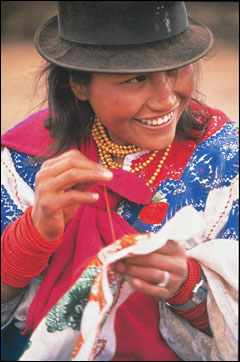
Ecuadorians were heavily concentrated in the
Andes highlands region a few decades ago, today
the population is divided almost equally between
that area and the coastal lowlands. Migration
toward cities, particularly Quito and Guayaquil,
in all regions has increased the urban population
to more than 50%. Due to the recent economic crisis,
more than half million Ecuadorians emigrated to
the U.S. and Europe, mainly Spain and Italy, from
2000 to 2001. The provinces with the greatest
number of immigrants are Pichincha and Guayas.
The tropical forest region to the east of the
mountains remains sparsely populated and contains
only about 3% of the population.
The official language of the country is Spanish,
but other languages, such as Quichua Shimi, Awapit,
Cha´palachi, Tsafiqui, Paicoca, A´ingae,
Huaotirio, Shuar-chichan, and Záparo, are
widely spoken in areas with large indigenous populations.
The predominant religion is Roman Catholic, but
there is a scattering of other Christian faiths.
Indigenous Ecuadorians, while outwardly Catholic,
tend to blend Catholicism with their traditional
beliefs. Many communities still preserve their
ancient beliefs of worship of the earth, the mountains,
and the sun.
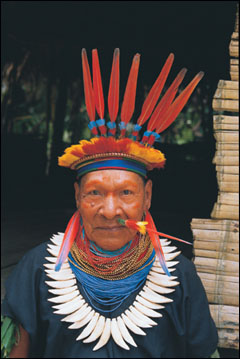
More than 14 indigenous groups live on the Ecuadorian
mainland, maintaining their own traditions and
ways of life. The principal indigenous groups
of the Amazon region: Huaoranis, Achuar, Shuar,
Cofán, Siona-Secoya, Shiwiar and Záparo.
The main indigenous groups of the highlands are
the Quichua -by far the largest group, amounting
more than 2 million-, Cañaris, and Saraguros.
In northern Ecuador, live the Awa community. On
the Pacific coast, live the Chachis, Cayapas,
Tsáchilas, and Huancavilcas. The nations
cities and villages are primarily populated by
people of mixed race, white, and Afro-Ecuadorians,
although large numbers of indigenous migrants
have moved from the country to the city.
 Culture Culture |
Amazonian frontier towns, Pacific coast fishing
villages, rambling old haciendas, packed markets,
and colonial cities provide the stage on which
Ecuador's cultures intermingle; each striving
to maintain its own identity and history while
also charting a meaningful path into the future.
Even outside these cultural crossroads, in a day,
because of Ecuador's compactness, one can experience
any number of Ecuador's distinct cultures.
The Amazon basin is equally as rich in indigenous
culture as the highlands. Despite increasing pressures
from the industrialized world, shamanistic traditions
still thrive within the rainforest worlds of the
Huaorani, Zaparo, Cofan, lowland Quichua, Siona,
Secoya, Shuar, and Achuar.
Modernization has not robbed Ecuador's cities
and towns of their distinct local flavors largely
because it is people not just historic sites that
give these places their character. Otavalo, long
famous for its warm, enterprising indigenous people,
continues its friendly tradition in the twenty-first
century. Banos, with its hot springs and agreeable
climate, welcomes visitors day in and day out
with unwavering smiles. And Quito, the country's
political center, has developed into a cosmopolitan
city while maintaining its small town candor and
geniality
|
Ecuador's pre-Columbian peoples excelled in pottery,
painting, sculpture, and gold and silver work.
The Spaniards trained indigenous artists to produce
colonial religious art, which can be seen in many
churches and museums. The Quito School of the
17th and 18th centuries combined these two influences
but was replaced by formalism after independence,
which favoured subjects such as heroes of the
revolution and members of high society.
Ecuador's colonial religious architecture is
predominantly baroque, although domestic architecture
tends to be simple and elegant, comprising whitewashed
verandahed houses built around a central courtyard.
Traditional Andean music has a distinctive haunting
quality based on an unusual pentatonic scale.
Wind and percussion instruments, including bamboo
panpipes and flutes, are staples of the sound.
Local crafts include fine examples of basketry,
leather work, woodcarving, weaving, ceramics and
jewelry.
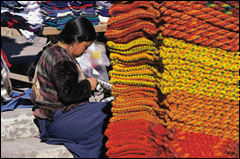
Ecuadorian food consists mainly of soup and stews,
corn pancakes, rice, eggs and vegetables. Seafood
is particularly good, even in the highlands. Local
specialities include caldo de pates, a soup made
from cattle hooves; cuy, whole roasted guinea
pig; and lechón, suckling pig. Guayaquil,
the heart of the south coast, has the gamut of
cuisines. Patacones, fried plantain chips, are
a favourite side dish of the coastal dwellers.
 Oswaldo
Guayasamin, Ecuador's best known artist Oswaldo
Guayasamin, Ecuador's best known artist |
Oswaldo Guayasamín was born in Quito on
July 6, 1919. Son of a Native father and a Mestiza
mother. Proud of his backgrounds, he creates trustingly
a portrait of the human and social differences
as criticism towards the reality that we live
now a days in our society. Oswaldo Guayasamín
dedicated his entire life to painting, sculpting,
collecting and fighting the injustices of life.
His death on March 10th, a day of national strikes
by indigenous (whom he spent his life supporting)
and other sectors of society, was a great loss
to Ecuador. He was one of our national treasures.
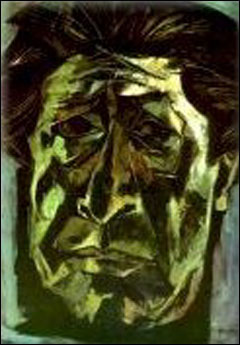
All of Guayasamín's paintings or sculptures
evoke an immediate reaction. The strong colors,
often disturbing images and forceful themes are
meant to make the patron stop and take notice.
Since early in his career, Guayasamin used art
to fight against the cruelty of life, violence
and injustice. "The Dead Children",
which is a group of naked cadavers, was based
on a brutal memory of when a childhood friend
and others were gunned down by a random bullet.
From then on, Guayasamín would continue
to use his paintings and sculptures to combat
"cruelties and injustices of a society that
discriminates against the poor, the indigenous,
the afro-ecuadorian and the weak" explains
the Guayasamín Foundation. He never belonged
to a political party, but rallied in support of
Castro and against the "abuses and aggressions
of powerful and imperialistic countries".
Sadly, the Ecuadorian Embassy had just convinced
him to do an exhibit in the United States, when
he died in Baltimore from a heart attack.
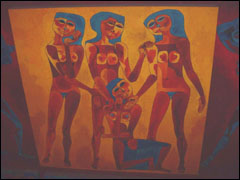
The Guayasamín Foundation was created
to showcase his most important works. It includes
a collection of pre-Colombian sculptures (3,000
pieces), colonial art (800 pieces) and his contemporary
pieces (250 works). In the contemporary gallery
his most forceful works from 1964 to 1984 are
exhibited. The Nazi invasions, the concentration
camps, Hiroshima, Vietnam, the "CIA sponsored
invasions of Panama and the Dominican Republic",
and the tortures and genocide by the dictators
of Latin America are all expressed through his
eyes and on his canvases.
Since 1996, Guayasamín had been working
on a life long dream, the creation of "The
Chapel of the Man" a 6,000 square foot mural
that could rival the Cixtine Chapel. It was meant
to be a history of "Our America" from
pre-Colombian times to the present. This masterpiece
was declared to be by UNESCO a "'cultural
priority". Saddly, Guayasamín was
not able to complete this dream.
Pablo Neruda described Guayasamín as "One
of the last crusaders of imaginativeness. His
heart is full of creatures, earthly pain, oppressed
people, tortures and signs.He expresses his all
and everything into painting. Fashions pass through
his head like flimsy clouds. He has no fear of
them". As Guayasamín rests in peace,
he will be remembered for all this and more -
for his political beliefs, his creativity, his
courage and his dedication. While Ecuador is being
torn apart, his art will unite us for one thing
- to mourn his passing.
|

